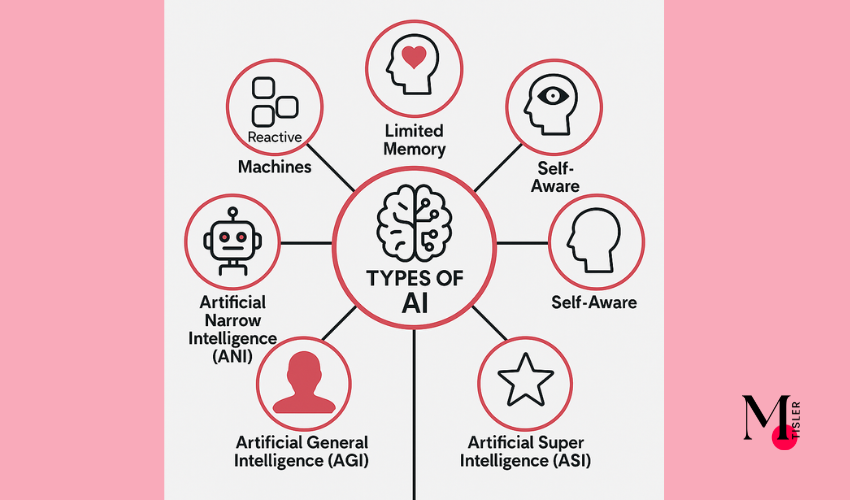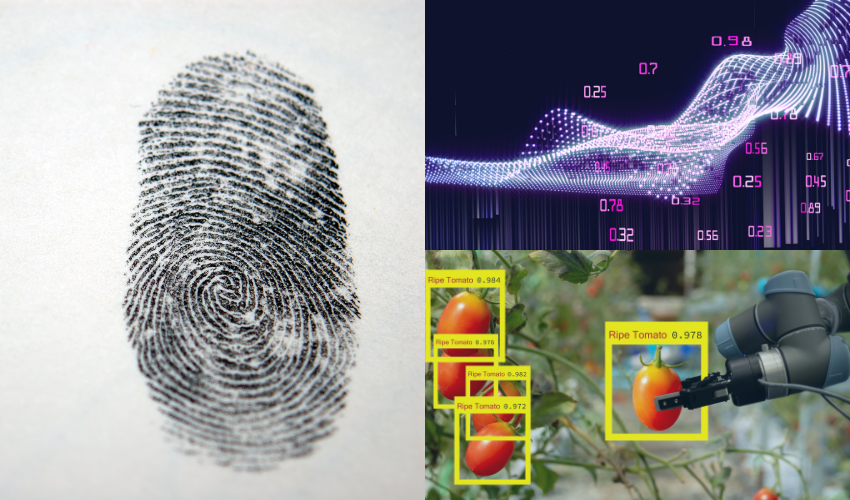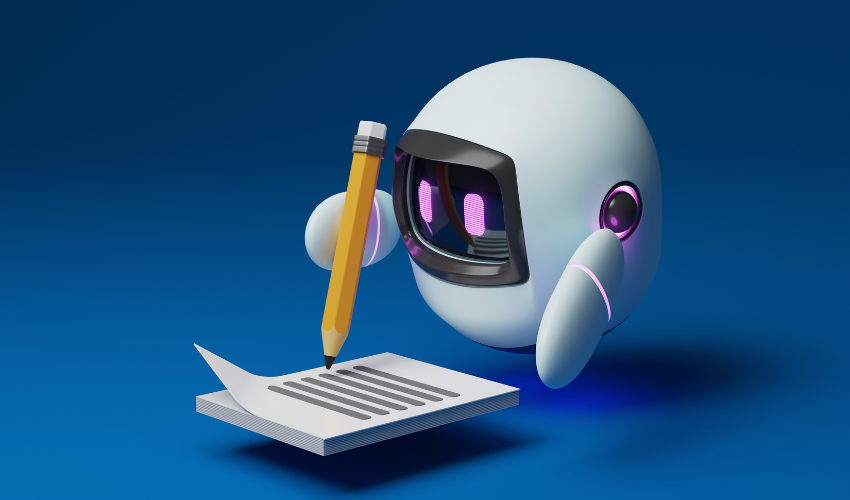Must-Know Types of AI for Tech Enthusiasts in 2025
Share it
The main types of AI show how machines have advanced from simple reactive tools to systems that can learn, adapt, and even interpret human emotions. Understanding these categories gives a clear picture of where AI is today and where it’s heading.
Imagine a time when machines mimicking human intelligence were just a fantastical science fiction idea.
Fast forward to 2025, and AI is no longer a futuristic concept but a part of our daily lives, ingrained in everything we do. From smart homes to sophisticated algorithms, AI has become UBIQUITOUS.
The evolution of the field of AI is a fascinating tale of human ingenuity. It goes beyond traditional computing, entering a realm where machines learn, adapt, and evolve.
This shift reshapes industries, revolutionizes problem-solving, and redefines how we interact with machines.
In this article, we’ll go through the fundamental types of AI you need to know in 2025.
Whether you want to enhance your expertise, engage in discussions, or satisfy your curiosity, understanding AI’s diverse types is essential. Let’s explore it!
What Are The Types of Artificial Intelligence by Categories?
The realm of Artificial Intelligence (AI) is vast and continually evolving, with each advancement PUSHING the boundaries of what machines can achieve.
At the heart of this exciting frontier lie four types of AI, each boasting distinct characteristics and capabilities.
As we embark on this exploration, it’s crucial to grasp the essence of these foundational categories, which will pave the way for a deeper understanding of the AI landscape.
1.) Reactive Machines AI
These AI systems are like the starting point of artificial intelligence.
They respond to specific stimuli without remembering past interactions. Their instant responses are solely based on the present input.
While they may seem simple, these reactive machines play a crucial role in different domains, laying the foundation for more advanced AI systems.
Real-world Example
An excellent example of Reactive AI Machines can be seen in the spam filters used by email systems.
These filters detect and respond to specific trigger words, phrases, or sender profiles to determine if an email is spam or legitimate.
For example, a spam filter may be designed to flag emails with phrases commonly associated with spam, such as “win a free iPhone” or “claim your lottery prize.”
Moreover, they carefully analyze sender profiles, flagging emails from unfamiliar or SUSPICIOUS addresses to ensure your inbox remains free from potential spam. Another fascinating example from history is IBM’s Deep Blue project, where a machine famously defeated a world chess champion using purely reactive AI strategies.
Security Concern
Reactive Machines, while simple in nature, can still have security VULNERABILITIES.
Malicious actors are adept at using advanced techniques to bypass these reactive measures.
Take spear phishing attacks, for example. They are carefully crafted to avoid detection by regular spam filters.
Unlike general phishing attempts, spear phishing is highly targeted and often involves impersonating trusted contacts or organizations.
This makes it easier to trick recipients into revealing sensitive information. Because of their tailored content and convincing disguises, spear phishing emails can slip past standard spam filters, posing a significant security risk.
Stay VIGILANT!
Mitigation
We need a comprehensive approach to enhance the security of systems using Reactive Machines.
One way is to implement Multi-Factor Authentication (MFA), which adds an extra layer of security.
With MFA, users have to provide multiple forms of identification before accessing their email accounts, making it harder for attackers to gain UNAUTHORIZED access.
But that’s not all!
Continuous user education is also CRUCIAL. By educating users about the tell-tale signs of phishing attempts and fostering a culture of caution when dealing with suspicious emails, we can effectively reduce the risk posed by phishing and other email-based threats.
Key Features of Reactive Machines AI
- Respond only to current inputs
- No learning or memory
- Perform predefined, specialized tasks
- Example: spam filters
2.) Limited Memory AI
Going beyond reactive machines, limited memory AI takes it up a notch by learning from historical data.
These AI systems make more intelligent decisions by analyzing past interactions, continuously improving performance.
Just look at their application in autonomous vehicles, where they learn from countless traffic scenarios to enhance safety and NAVIGATION. It’s truly AMAZING to witness their learning capabilities in action.
Real-world Example
Tesla’s Autopilot feature is an awesome demonstration of limited memory AI in action!
The system constantly collects data from various on-road scenarios, using the vehicle’s sensors, cameras, and the collective data from all Tesla vehicles. This wealth of data helps enhance the driving algorithms, making the autopilot feature even safer and more efficient as time goes on. HOW COOL IS THAT? 😎
Security Concern
Limited memory AI comes with an important consideration: the risk of data tampering.
It’s crucial to be aware that malicious actors can manipulate the data that AI learns from, which can result in misleading or INCORRECT outcomes.
For example, tweaking traffic sign data has the potential to misguide autonomous vehicles, putting SAFETY at risk.
Stay VIGILANT and ensure data integrity for a safer AI future.
Mitigation
Ensuring the integrity and security of the data that limited memory AI learns from is crucial.
Robust data validation and encryption measures play a vital role in this.
We can greatly reduce the risk of data tampering by employing cryptographic techniques for secure data transmission and validating authenticity through checksums or DIGITAL signatures.
Key Features of Limited Memory AI
- Learn from historical data
- Improve decision-making over time
- Require continuous data updates
- Example: autonomous vehicles
3.) Theory of Mind AI
Theory of Mind AI seeks to create machines that comprehend and react to human emotions, transforming human-machine interaction.
This exciting objective propels AI into a realm where machines can intuitively and empathetically engage with humans, enhancing the HUMAN experience.
Real-world Example
Exciting progress in emotion recognition technology showcases the remarkable advancements in AI toward achieving the Theory of Mind.
By analyzing facial expressions, vocal nuances, and textual sentiment, these AI systems aim to understand human emotions, enriching user experience in customer service, mental health monitoring, and INTERACTIVE gaming environments.
Security Concern
The potential misuse of emotion recognition technology is a matter of GREAT concern.
Unauthorized or malicious use could violate personal privacy or exploit emotions for negative purposes, like misleading advertising or PROPAGANDA.
Mitigation
Maintaining strict regulations and transparent consent processes is key in overseeing the ethical deployment of emotion recognition technology.
It’s important to ensure that individuals are well-informed and have control over how their emotional data is used. With regulatory OVERSIGHT, we can prevent misuse and protect PRIVACY, fostering a safe and trustworthy environment.
Key Features of Theory of Mind AI
- Understand emotions and beliefs
- Adapt responses based on social context
- Still under research, and not fully realized
4.) Self-aware AI
The pinnacle of AI evolution, self-aware AI, is still mostly theoretical.
Imagine machines with a consciousness similar to humans, capable of introspection and understanding their place in the WORLD.
It’s a fascinating idea that sparks discussions and ETHICAL debates. Self-aware AI represents the incredible potential and CHALLENGES that lie ahead in the AI journey.
Real-world Example
Although true self-aware AI remains a theoretical concept, some projects offer glimpses of progress toward self-awareness.
Take OpenAI’s GPT-3, one of the most advanced language processing AIs. It demonstrates a form of contextual understanding that, while not quite self-aware, represents a REMARKABLE leap in AI’s ability to interact with information more nuancedly.
Pretty cool, HUH?
If you want to explore how experts are thinking about conscious AI, this article on the possibilities of conscious AI offers a clear and thoughtful overview.
Security Concern
The ethical and security implications of highly autonomous, self-aware AI are truly PROFOUND.
We must consider the potential for misuse, loss of control, or even the risk of AI developing objectives that are misaligned with human values.
Mitigation
The conversation about self-aware AI highlights the significance of strong ETHICAL frameworks and careful oversight of MECHANISMS.
By establishing ethical guidelines, implementing rigorous testing and validation protocols, and developing international REGULATORY frameworks, we can navigate the complex ethical landscape surrounding self-aware AI in a structured and RESPONSIBLE manner.
Key Features of Self-Aware AI
- Hypothetical consciousness in machines
- Ability for introspection and self-reflection
- Raises major ethical and philosophical questions
Wrapping up
Discovering these fundamental types of AI not only gives us a glimpse into the present state of AI but also SPARKS our imagination about the possibilities that lie ahead.
As we delve deeper into each type and explore the subcategories of AI, we’ll unveil a world where the collaboration between HUMANS and machines constantly pushes the LIMITS of what we can achieve.
Diving Deeper into AI Classification
Artificial Intelligence is not a monolith but a CONGLOMERATE of various technologies, each with its unique capabilities and applications.
As we venture beyond the core types, we stumble upon subcategories of AI that are making significant STRIDES in various domains.
These subcategories, including Machine Learning (ML), Deep Learning, and Natural Language Processing (NLP), offer a glimpse into the specialized realms within the broad SPECTRUM of AI.
1.) Machine Learning (ML)
Machine Learning (ML) is an incredible subset of AI that empowers machines to learn from data, improve over time, and make predictions or decisions without explicit programming. It’s the driving force behind many digital conveniences we love today.
Real-world Applications
📈 Predictive Analytics: Businesses use ML to analyze historical data and predict future trends. For example, retailers can forecast sales, while financial institutions can predict stock market trends.
🔒 Fraud Detection: ML algorithms learn and monitor normal transaction patterns, flagging anomalies that may indicate fraudulent activities. This provides an essential layer of security in the financial sector.
🎯 Personalized Marketing: ML analyzes customer behavior and purchase history, enabling personalized marketing. This enhances customer engagement and boosts sales.
2.) Deep Learning
Deep Learning, a fascinating subset of ML, takes data analysis to the next level by utilizing neural networks with three or more layers. These neural networks can analyze massive amounts of data, uncover intricate patterns, and provide highly accurate predictions.
Real-world Applications
🖼️ Image Recognition: Deep learning excels in image recognition, powering technologies like facial recognition and medical image analysis to diagnose diseases.
🎙️ Speech Recognition: Voice-activated assistants like Siri and Alexa rely on deep learning to understand and respond to user commands.
🌐 Language Translation: Services like Google Translate leverage deep learning for real-time translation, bridging language barriers across the globe.
3.) Natural Language Processing (NLP)
Natural Language Processing (NLP) is where the magic happens! It’s at the intersection of linguistics and AI, empowering machines to understand, interpret, and generate human language. This incredible capability fosters natural interactions between humans and machines, making our lives more seamless and enjoyable.
Real-world Applications
🤖 Chatbots: NLP gives chatbots the power to understand your queries and respond just like humans, providing top-notch customer service.
🗣️ Voice Assistants: Say hello to Siri and Google Assistant! NLP helps them understand and respond to your voice commands, making everyday tasks a breeze.
😄 Sentiment Analysis: NLP comes in handy for businesses to analyze customer feedback and social media conversations, helping them gauge public sentiment towards their brand or products.
The Practical Applications of AI Technology
The realm of Artificial Intelligence (AI) is not just limited to theory; it has PRACTICAL applications that are transforming industries, driving INNOVATION, and creating new ways of doing things. In project-based work, AI project management tools streamline planning, scheduling, and risk management by combining automation, machine learning, and predictive analytics. Let’s dive into how different types of AI are making a BIG impact across various sectors.
Healthcare
- Predictive Analytics for Patient Care: By using machine learning algorithms, we can analyze a patient’s historical data to predict potential medical issues before they become critical. This allows us to provide proactive care and better outcomes.
- Radiology Imaging: Deep learning technologies are revolutionizing the analysis of radiological images. With their help, we can now detect diseases like cancer at an early stage, improving the chances of successful treatment.
Finance
- Fraud Detection: With the help of ML and AI algorithms, we can sift through enormous datasets to detect fraudulent activities, ensuring the safety of your financial assets.
- Robo-Advisors: Experience the revolution in investment strategies with AI-powered robo-advisors. They provide personalized investment advice with minimal human intervention, making it easier for you to make informed decisions.
Retail
- Supply Chain Optimization: Embrace the power of AI to predict demand, optimize stock levels, and enhance the efficiency of your supply chain. Let us help you streamline your operations and maximize your success.
- Personalized Shopping Experience: Enjoy a personalized shopping experience like never before! Our AI technology analyzes your past purchases and browsing behavior to offer tailored recommendations, making your online shopping journey more enjoyable and convenient.
Are you curious about even more real-world AI applications? Discover how AI is reshaping industries beyond healthcare, finance, and retail.
Future Trends: Beyond the 4 Types of AI
The journey of AI evolution is absolutely fascinating! As we explore the uncharted territories of AI, it becomes crucial to understand the distinctions between Artificial Narrow Intelligence (ANI), Artificial General Intelligence (AGI), and Artificial Superintelligence (ASI) to grasp the future trends in AI development.
Artificial Narrow Intelligence (ANI)
ANI, also known as Weak AI and Narrow AI, is pretty impressive when it comes to handling specific tasks or a set of closely related ones. It operates within a specific domain and cannot transfer knowledge from one domain to another.
Examples of Narrow AI are popular technologies like Siri, Alexa, and other task-specific Narrow AI applications are great examples of ANI. They excel in their designated tasks but fall short when it comes to generalization.
Ethical Considerations: The use of ANI raises concerns about data privacy, bias, and the potential for misuse, especially in areas like surveillance. Moreover, the lack of transparency in decision-making processes and the automation of jobs can lead to significant ethical dilemmas.
Artificial General Intelligence (AGI)
AGI, or Strong AI and General AI, is a type of AI that can comprehend, learn, and apply knowledge across a wide range of domains, much like humans.
For instance, while AGI remains primarily a theoretical objective, projects like OpenAI’s GPT-3 offer glimpses into advancing our understanding and application of knowledge in various contexts.
Ethical Considerations: The journey towards AGI raises ethical concerns to a whole new level. AGI’s autonomy brings forth potential risks in decision-making that could significantly impact human lives, particularly in critical sectors such as healthcare or law. Moreover, the potential for AGI to be misused, whether through malicious intent or inadequate oversight, emphasizes the pressing need for robust ethical frameworks.
Artificial Super Intelligence (ASI)
ASI, or Super AI, surpasses human intelligence in all imaginable fields, including creativity, overall wisdom, and problem-solving. The emergence of ASI marks a new era where AI has the potential to outperform humanity in every aspect.
For instance, ASI is still a concept that is open to speculation. Visionaries like Nick Bostrom foresee a future where ASI could tackle intricate global challenges or, on the flip side, pose existential risks if not properly managed.
Ethical Considerations: The progress towards ASI sparks lively ethical debates regarding job displacement, privacy concerns, and the responsible use of highly advanced AI.
Wrapping up
The journey of AI evolution is absolutely fascinating! As we explore the uncharted territories of AI, it becomes crucial to understand the distinctions between Artificial Narrow Intelligence (ANI), Artificial General Intelligence (AGI), and Artificial Super Intelligence (ASI) to grasp the FUTURE trends in AI development.
Getting Hands-on with AI
If you’re intrigued by the potential of AI, it’s time to dive right in and get hands-on with this fascinating domain. Here are some awesome ways to get started:
Online Courses
Check out platforms like Coursera and Udemy – they offer a wide range of AI, ML, and Deep Learning courses. These courses provide a structured pathway for mastering the basics and beyond.
Collaborative Platforms
Looking to collaborate on projects and connect with like-minded individuals? GitHub and Kaggle are the places to be. Engage in competitions, work on projects together, and join a vibrant community passionate about exploring AI.
Community Engagement
Don’t forget to join AI communities and forums. They’re treasure troves of insights, mentorship, and networking opportunities for anyone eager to immerse themselves in AI projects and a career in artificial intelligence.
Continuous Learning and Adaptability
To excel in an AI-driven workplace, it’s crucial for employees to have a passion for continuous learning and adaptability. If you’re interested in understanding the impact of AI in the workplace, explore how businesses are transforming with intelligent technologies. Organizations should invest in training programs that empower their workforce with the skills to work hand in hand with AI tools.
Investing in the Right Infrastructure
For AI to work at its best, businesses should prioritize investing in the right infrastructure. This means having robust data management systems, high-speed internet, and top-notch hardware.
Fostering Collaboration
The success of AI in the workplace relies on collaboration among data scientists, industry experts, and end-users. By encouraging cross-functional collaboration, businesses can ensure that AI solutions are custom-made to tackle specific business challenges.
FAQ
What is artificial intelligence?
Artificial intelligence (AI) refers to the simulation of human intelligence in machines that are programmed to think and learn like humans. It involves studying and developing computer systems that can perform tasks that normally require human intelligence.
What is a neural network?
A neural network is a type of artificial intelligence system designed to mimic how the human brain works. It consists of interconnected nodes, or “neurons,” that process and transmit information. Neural networks are commonly used in machine learning models.
What are generative AI models?
Generative AI refers to the use of artificial intelligence systems to create new and unique content. It involves training a model on existing data and allowing it to generate new data that is similar to the training examples.
What is an expert system?
An expert system is an artificial intelligence system designed to provide expert-level knowledge and advice in a specific domain. It uses a knowledge base and inference engine to reason and make decisions.
How is AI different from machine learning?
AI is a broader concept that refers to the simulation of human intelligence in machines, while machine learning is a subset of AI that focuses on the development of algorithms that allow computers to learn and make predictions or decisions without being explicitly programmed.
What are some examples of artificial intelligence systems?
Examples of artificial intelligence systems include reactive machines like chess-playing programs, limited memory systems like autonomous vehicles, theory of mind AI prototypes in emotion recognition, and emerging concepts related to self-aware AI.
What are the different types of artificial intelligence systems?
The main types of artificial intelligence systems are Reactive Machines, Limited Memory, Theory of Mind, and Self-Aware AI. Future AI research also explores Artificial Narrow Intelligence (ANI), Artificial General Intelligence (AGI), and Artificial Superintelligence (ASI), which reflect broader levels of AI capability.
How is AI used in the field of machine learning?
AI and machine learning are closely related. AI provides the overall framework and concepts, while machine learning focuses on developing algorithms and models that enable computers to learn from data and improve their performance on specific tasks.
What are the potential career opportunities in the field of artificial intelligence?
The field of artificial intelligence offers a wide range of career opportunities, including AI researcher, data scientist, machine learning engineer, AI consultant, robotics engineer, and natural language processing specialist.
What is the difference between ANI, AGI, and ASI?
ANI (Artificial Narrow Intelligence) focuses on specific tasks, like personal assistants or spam filters. AGI (Artificial General Intelligence) would match human cognitive abilities across any domain. ASI (Artificial Superintelligence) would exceed human intelligence in all fields, presenting both opportunities and risks.
Further reading on MyriamTisler.com: Learn about practical AI Applications in various industries.
Discover the benefits of AI in improving efficiency and decision-making in AI in the Workplace.
Why Is Change Management Important explains how effective change management can drive project success.
Check out ChatGPT Training. and learn how it can be used to enhance communication and automate tasks.
Conclusion
There is no doubt that all these types of AI are improving our lives. From healthcare to financial technology, AI has an undeniable place in the modern world.
It’s time to dive headfirst into this fascinating realm and join the revolution. Don’t be afraid – even if you know nothing about AI, try taking a class or two in robotics, data science, or artificial intelligence.
The possibilities are ENDLESS, and plenty of resources are out there to help get you going on your journey. Start exploring and become a part of something bigger than yourself.
Types of AI explain how artificial intelligence has evolved from reactive machines to advanced systems exploring emotional intelligence and theoretical self-awareness. This article breaks down the four main categories: Reactive Machines, Limited Memory, Theory of Mind, and Self-Aware AI, with real-world examples like spam filters, autonomous vehicles, emotion recognition, and language models. Readers will learn about the key features, benefits, and risks of each type, as well as the ethical and security considerations that are shaping AI’s future. The result is a clear, engaging guide to understanding the foundations of artificial intelligence in 2025 and beyond.

Hi, I’m Myriam.
I love blending tech with change management, user experience, project management, business analysis, streamlining processes, improving customer journeys, and designing business structures. While I’m not the top expert, I enjoy exploring these areas and sharing my insights. Whether it’s for large corporations or small startups, I’m passionate about finding efficient ways for them to work. I enjoy experimenting with new recipes and attending artsy events when I’m not doing that. This blog is my space to chat about all the cool business and tech topics I have discovered.










